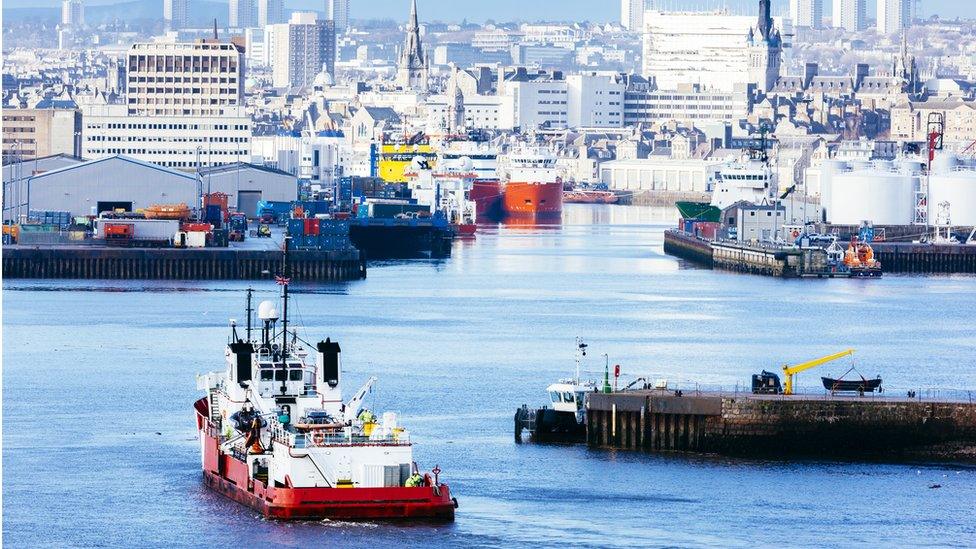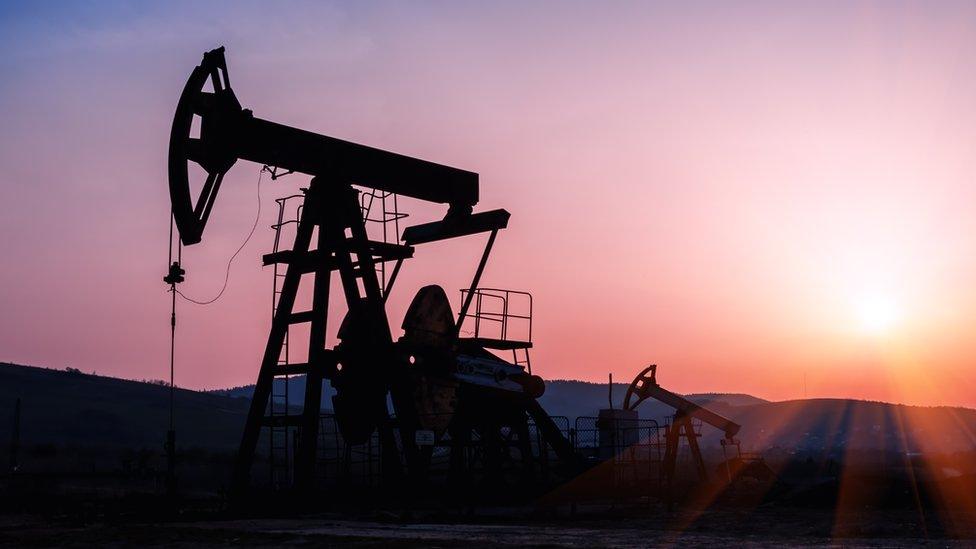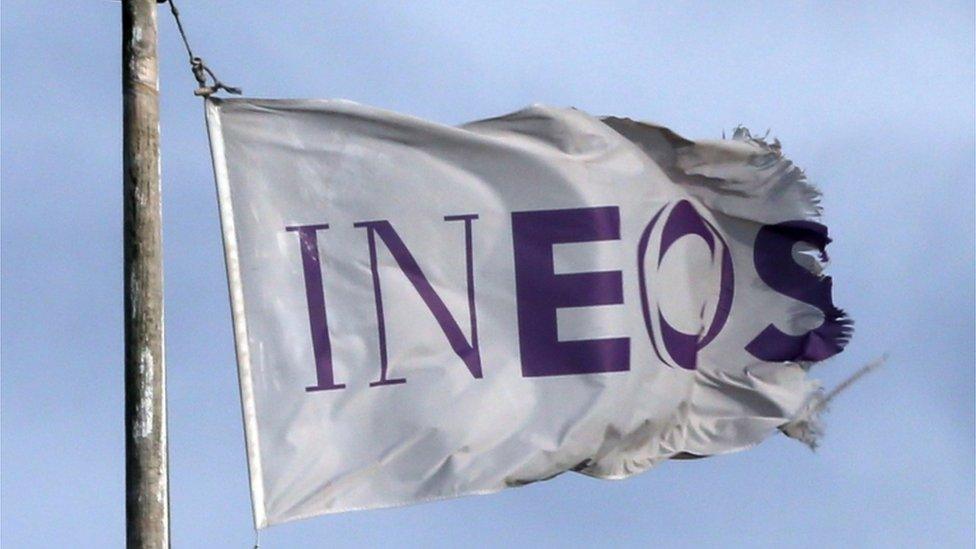Oiling the rollercoaster
- Published

A low oil price has hit production in Scottish waters
Opec, the oil exporters club, last year pulled back on production to put a floor under the price. Now, their concern is that they need to put a ceiling on it.
The price of that familiar benchmark barrel of Brent crude oil, from the waters off Aberdeen, has been rising in recent days, reaching $69.30 on Wednesday.
It was at $45 last July. It dipped to $30 two years ago. But in summer 2014, it was at $115.
Good news for oil producers, after three very tough years. Not so much for oil consumers. Forecourt prices are clearly on the rise.
So, some questions. Will the price keep pumping upwards? What impact does this have on the industry and on tax revenue in Britain? And (an old favourite, this) on the case for or against Scottish independence? But first...
Why?
Traders are a jittery bunch - particularly, it seems after they come back from their festive break.
A dose of unprecedented reforms in Riyadh. Some big protests against the ruling clergy in Iran. A blast of very cold weather in the US.
A crack in the Forties Pipeline through which Brent crude itself flows closed it down and also helped push up the December jitter factor.

Protests in Iran have spooked the oil market
There are also fundamentals. The global economy is doing very nicely. Today's UK manufacturing figures from the Office for National Statistics reflected that, with exports going especially well.
And while the link from economic growth to growth in demand for energy is not as clear as it was, it's still there.
Will it continue?
That's where the other side of the market fundamentals come in: supply.
Opec pulled back output to bolster the price, and for the past year, it has had the desired effect. The price of Brent crude bobbed happily around the $50-$60 zone.
The agreement to continue that supply constraint throughout 2018, agreed with non-Opec Russia, seems to have bolstered the price more than expected. The Opec market modelling may not have foreseen the strength of global demand feeding through from growth.
But there are market analysts who don't see the current price as being supported by the data they're looking at.
And the Iranian energy minister has given verbal warning that Opec is not happy about the price nearing $70 - the first sign that the cartel could take action to lower it, by turning the taps on.
To answer the question, a key number to watch is the Baker Hughes land rig count. That company has been counting US drilling rigs since 1944, sending investors a signal of industry activity.

Oil is still being pumped from the ground in Texas
Across the US, the count is up by by 259 in the past year to 924 by 5 January. The last year's growth has been fastest in the south. The Texas rig count has risen by 127 since the start of last year, to 454. In the state of New Mexico, it is up by 39 to 76.
Shale fracking drillers are back at work because the price is now high enough to justify the investment. They can quickly push up production. The US government's energy analysts have pushed up their forecast of output by four times in the past few months.
It's reckoned it could top 11 million barrels per day, or more than a ninth of global production.
You might think Opec should welcome higher prices: what they don't welcome at all is a higher US market share.
It gives you some sense of the turnaround in that part of the industry if you look at the share price of Glasgow-headquartered Weir Group, which is a leading supplier of fracking equipment. That was at 848 pence in January 2016. Today, it's trading in London at around 2300 pence.
So what impact on the UK offshore industry?
A higher oil price can bring in higher investment in production levels and in exploration. That much seems obvious.
But unlike fracking in the Permian basin of central Texas, you can't drill and dump in offshore production. The rewards can be huge, but the investment is too, particularly offshore.
Once committed, you've got to stay there, through low prices and high. Plus, there's a much higher risk of coming up dry when drilling conventional exploratory wells.
The energy analyst Westwood this week looked ahead to 2018 upstream prospects in "northwest Europe", concluding that UK exploratory drilling will remain at the same low level as last year - only 15 wells.

Conditions have been stormy for the North Sea industry
In Norwegian waters, despite some disappointing results of late, the firm foresees a sharp increase in exploration compared with the past two years.
Wood Mackenzie, on Wednesday, released its outlook for the upstream year ahead, and agreed on the 15 exploratory wells, with "all eyes west of Shetland", and small independent companies more active than the majors.
The Edinburgh-based energy consultancy was more upbeat about UK production, rising to 1.9 million barrels per day as big new developments Clair Ridge and Mariner, both near Shetland, are scheduled to come on stream.
That will be the last of the big projects which were sanctioned in the 2010 to 2014 boom, says WoodMac. It should take UK production this year to the highest point since 2010, and up by 25% since 2014.
Development spending, to extend the lives of oil and gas fields for instance, looks more downbeat. Estimated at $6.2bn, that would be a fifth down on 2017 and the lowest level since 2000.
There could be up to 14 projects given the green light for investment, but they won't be enough to stem the accelerating decline in production from onstream fields.
So while a higher oil price may help these projects get through the final investment gateway, they're not expected to change the trajectory of the offshore industry, returning to a decline in production from the end of this decade.
What does this mean for UK tax?
Rising production and the rising price towards the end of last year meant that the Office for Budget Responsibility raised its estimate of tax take from profits on UK oil and gas production. They had been close to zero or even into negative amounts, and rose to around £1bn over the next few years.
If the OBR were to rework the figures now, the estimates would probably be higher.
The problem for the Exchequer is that the new fields are the ones that have been incentivised with tax breaks. And the new fields are becoming more and more important, as old fields fall away.
This year, Oil and Gas UK, the group that represents the industry, believes that 600,000 barrels per day - nearly a third of all UK production - will be from only 10 new fields.
As much as a fifth will come from the new frontier west of Shetland. And the ratio of new fields to ageing ones becomes much more important into next decade.
What about the finances of an independent Scotland?
Such talk excites those who want Holyrood to take control of oil revenue, and either to spend it in an independent Scotland or to put it into an investment fund, as Norway has done, and very successfully so.
What is sometimes missed is that Norway's benefits have accrued from both tax and from dividends on owning a large stake in its offshore industry. None of the UK's offshore reserves or production are publicly owned. No dividends come to the Treasury.
What is also often forgotten in the excitement is that a large part of the Scottish economy is a consumer of energy, and while higher oil prices can boost tax revenues, they can suppress profits elsewhere, and economic growth.
Anyway, the best estimates are of the value of oil and gas revenue being 83% to more than 90% from Scottish waters. So that could bring in, very roughly, £1bn a year to a Scottish exchequer.

Oil is not the money machine it was for Scotland's economy
But with government in Scotland spending more than £70bn, more than £13bn ahead of the tax notionally raised in Scotland, a billion quid doesn't come close to closing that gap, and it cannot also be put into that trust fund.
The Scottish Growth Commission, set up by the Scottish National Party under former MSP Andrew Wilson, is expected to report next month, reworking the proposals for an independent Scotland's economy, to replace the White Paper from 2013.
Under Alex Salmond, that had selected statistics from the booming start of the decade that made revenue look very rosy, with optimistic assumptions that it could stay that way.
Wiser heads within the movement said during the independence referendum campaign, and will still tell you now, that oil revenue in future should be treated as "nice to have" rather than being a central plank of economic planning and essential to paying the bills for public services.
If Texans can frack, why not Scots?
There is some potential for fracked onshore oil and gas from under Britain, but the Scottish government has said it will effectively block any planning application for that to happen north of the border.
That led to an announcement this week from Ineos, the company that most wants to drill underground, that it will seek a judicial review of the ministerial decision.
That decision weighed up evidence on the the environmental, health and economic impact of unconventional gas developments, as well as public support. It was that final element that swayed the decision. Ineos argues that it wasn't clear at the start of the consultation process that public opinion would carry an effective veto.
Along with its partner, Reach, it says it has spent millions on developing its plans so far, and buying licences form other companies.
So it may pursue the Scottish government for compensation.

Ineos is taking on the Scottish government
I'll leave it to the judges to decide on the legal matters. But one consideration in terms of public policy is the immense clout of Ineos - a private company effectively controlled by one man, Jim Ratcliffe, and based in Switzerland.
It owns Scotland's biggest industrial complex - Grangemouth refinery and petro-chemical plant, which supplies the refined petrol and diesel that keep Scotland moving.
Ineos now has ownership and control of the Forties Pipeline Network. As we learned when it had to be closed down last month, that brings ashore about 40% of oil and gas production from the North Sea, and 85 fields depend on it.
It has bought up oil and gas assets in the North Sea and around Shetland, becoming one of the top 10 producers in UK waters, with plans to drill north of Shetland.
In short, and to put it mildly, a relationship of mistrust and litigation between Ineos and the Scottish government may not be that good for the economy.
Mayor versus majors
And finally, talking of litigation, there are those who take no pleasure in further investments to pump oil and gas from under the sea or land. They point to the environmental damage from burning the stuff.
So they'll be delighted to learn that the city of New York is taking legal action against the big oil majors to pay up for the damage their emissions have wreaked, and will continue to wreak, to the Big Apple's health and wellbeing. Those in its sights include BP and Royal Dutch Shell.
Lesser governments in California are already on the legal case.
In Manhattan, Mayor de Basio's intention, it seems, is to extract lots of cash, but also to tie up the oil industry in the courts - to such an extent that the energy firms accelerate the shift to low and no carbon energy, on which they would wish to emphasise that most have already embarked.